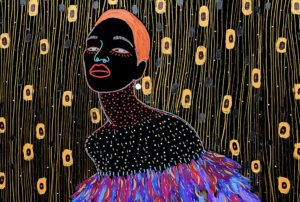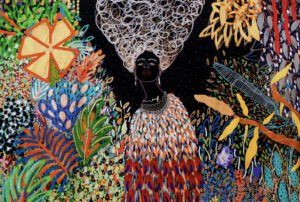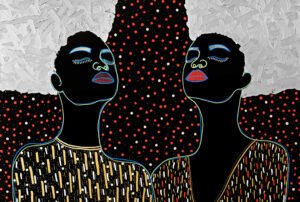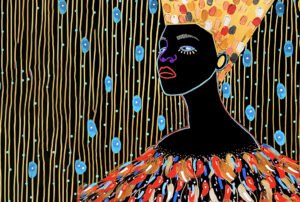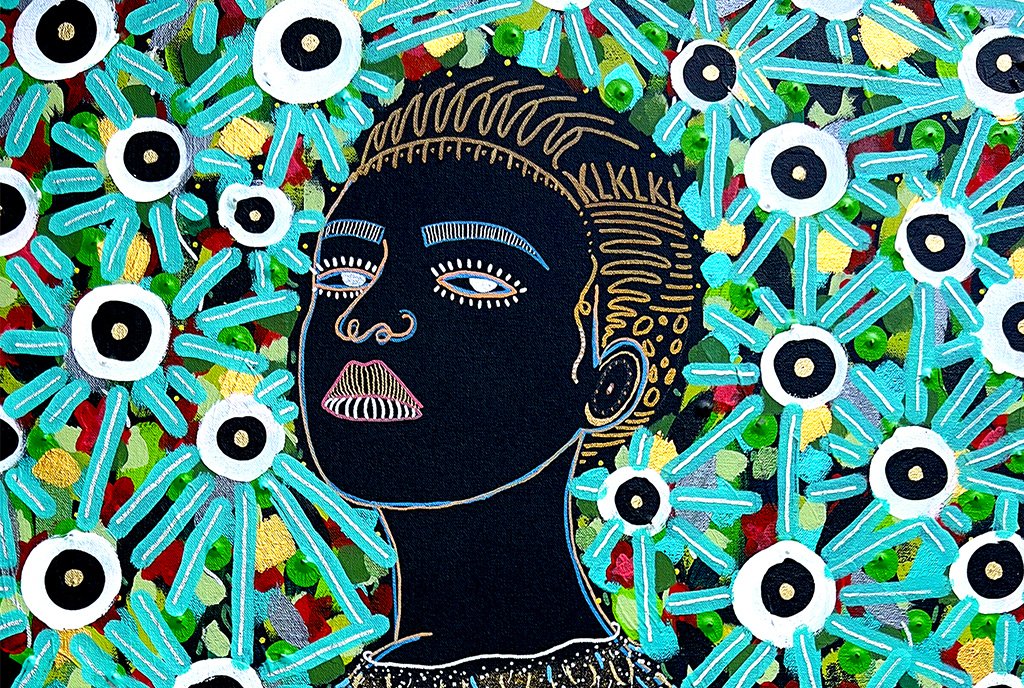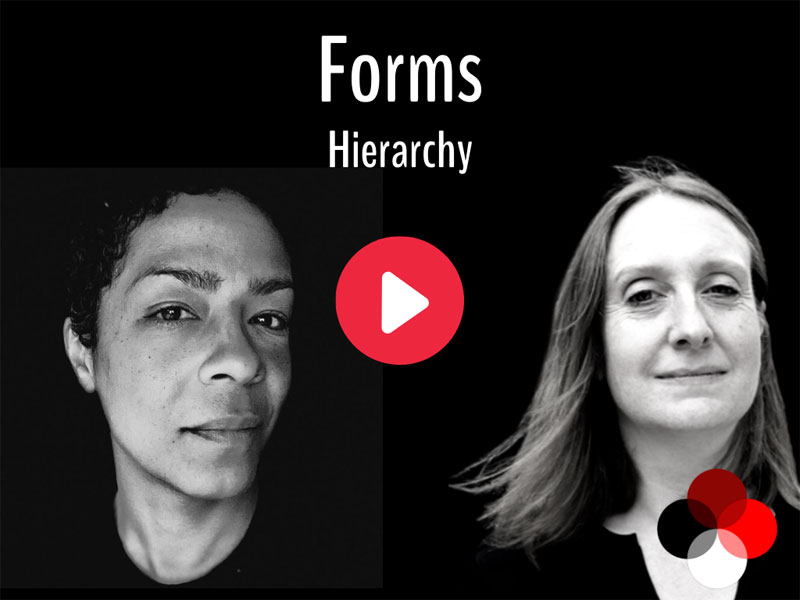
Cyndi Suarez, editor in chief of Nonprofit Quarterly and founder of Edge Leadership, invited Caroline Levine, author of Forms: Whole, Rhythm, Hierarchy, Network and professor of English at Cornell University, to talk. In this clip they explore the function of hierarchy.
Cyndi Suarez: I think hierarchy’s a really great example. I’m also curious as to the limitations within networks. I’d love to hear about that, but can we talk about hierarchy for a minute? Because it’s the one thing that I get often called [about]. Here at NPQ, Nonprofit Quarterly, I get a lot of calls, people asking for alternatives to it. And then, just as much, I get people in power that are in a hierarchy [that] almost rebuff that. Like, it’s such a thing…People are just like, “Ugh, I don’t know what these people think they’re going to do. I mean, how otherwise would we organize ourselves for scale,” or whatever, you know?
So, I also have been thinking a lot about this, and I started to research hierarchy and found a lot of the good things about it. That it holds complexity, that nature replicates it in a way that allows for a certain kind of…there’s some kind of way that it holds more. There’s a logic to it that allows you to bunch more things together, which is just how our brain works, right? You can’t design against the brain, right now. (I don’t think so, anyway.) I think that’s really fascinating.
And then I had a really interesting conversation a few weeks ago with a hierarchy engineer. I was so fascinated by the fact that he existed. I didn’t know that was a thing. He shared with me this whole other aspect of hierarchy: what he does is, he goes into systems and then fixes them. He says that what we have mostly is dysfunctional hierarchies. Because what a hierarchy is actually supposed to do is…each layer is supposed to hold more complexity than the layer below and to interpret it for the layer below. And if it can’t do that, then it becomes dysfunctional. People say, if you’re in an organization and you’re “below,” you have more ability to hold complexity than the layer above, which is almost like the normal nonprofit right now, right? Where you have a lot of leaders of color, a lot of people that are really connected to the field, and you have mostly white leaders still, and boards. There’s such a tension around that it’s getting called [out], like we need something beyond hierarchy. But I thought it fascinating that we don’t even look at what it’s supposed to do, and even if it was working well, the fact that even if we just arranged it because we, actually…
I mean—and this is what’s so controversial about this particular line of thinking, not sure if it’s right or wrong—but what this author who writes about hierarchy like this, which… (I can find his book, I have it somewhere around here [the book is called Requisite Organization, by Elliott Jaques].) He talks about that you’ll never have equality because people have different abilities to hold complexity. I’ve had other people talk to me about this as well, that there is a way that hierarchy…We talk about it in terms of power. But another way to think about it is in terms of mastery. You do actually want people that have a certain ability to be at the—you know—at some point where it merits, right? Like, it helps the whole.
Caroline Levine: Yeah. I mean, as you talk, I feel like I’ve got all these thoughts and some of them are, you know, fear. It’s like, let’s not embrace it, right? [Cyndi: Right.] Presumably, we all have some of that, too. So, how do we even think a thought that feels intrinsically dangerous? [Cyndi: Right.] And that’s okay. I mean, I think these are places—
Cyndi: I feel that too.
Caroline: Yeah, so, just to acknowledge that this is scary stuff.
Part of the problem of hierarchies is that they feed on each other. So, we have gender hierarchy, a race hierarchy, a wealth hierarchy, and then also an institutional power hierarchy—and look! They look the same! The people at the top look like the white, straight, male, wealthy people, right? This isn’t an accident; the hierarchies are supporting one another. But we can deplete or address the injustice of hierarchies while preserving some of the things that they do well by introducing other forms.
And so, one of my favorites—which is a little different from what you’re saying, Cyndi, but maybe we could think about it together—is rotating positions. I don’t know whether I can hold complexity until I’ve been in that position, right? Like, who knows who’s good at this thing? And if we decide, “Oh, well, you know, so-and-so who happens to belong to all the majority groups happens to be really good at holding complexity,” right? Then we’re reinforcing all the hierarchies, all at once. We’re allowing them to sediment each other. But what if we all try this?
I’m an educator, too, so I feel, like, what about learning about complexity? How do we introduce people to complexities that they might not be automatically skilled at, but we can help them to learn? So thinking about in organizations, how do you rotate people through positions where they can get some sense of the complexity that the organization represents?
To me, that’s incredibly important to understanding power, too. Because I find…I’m in an organization that’s a university. It’s really a complex organization in lots of ways. But the people who don’t participate in the administration of the university assume a really simple power hierarchy. They believe the president is more powerful than the dean, who’s more powerful than the professors, who are more powerful than the student. But actually, power doesn’t work quite that way. I’m constrained in all kinds of ways by other forms. Much as I might like to make my colleagues teach at seven in the morning, I can’t, right? There are rules about that. So, how does power actually operate through these multiple forms? And the higher you go in the institution, the more you can see of those different forms in the way that they’re working.
So, could we help people develop the methods for holding complexity? Could that be a training, or a way of thinking? And that’s where I think, “Oh, yeah, we’ve got the skills for that in the arts. We know how to do that kind of analysis.”
Domination vs. Developmental Hierarchies
In this clip featuring participants Amina Khawja, Danielle Coates-Connor, Gibrán Rivera, Huda Al-Saedy, and Kenneth Bailey, Cyndi and Caroline explore the differences between developmental and domination hierarchies.
Sign up for our free newsletters
Subscribe to NPQ's newsletters to have our top stories delivered directly to your inbox.
By signing up, you agree to our privacy policy and terms of use, and to receive messages from NPQ and our partners.
Cyndi:Some of the folks that I know that have been in conversation with me about my book, The Power Manual, are using it in their organizations. One of the things I’ve heard back almost consistently is—and I talk about this in the book—that there’s work on both sides. There’s work to stepping into power, and there’s work in stepping back and kind of sharing power—like, not taking all the power. And people were saying that there was actually not a lot of language for how people, especially people of color [and] women, step into power, that that was actually the hardest thing to do because of the associations with it, the lack of comfort with it, how to do it well…just language and space to even think about that.
I think that this idea of what’s dangerous undergirds a lot of these things, even though they seem really—you know, people think about infrastructure and forms as sterile things. People are like, “Oh, you’re gonna have a conversation about infrastructure and forms? Like, who goes to that?” But, when you say dangerous, it kind of hints at something more. So, I want to explore that idea for a little bit before we open it up in a few for questions. Anything about that idea that this is dangerous?
Caroline: Definitely. I mean, I feel like it’s one of the things that, in the arts, we have as part of our stable of things we can do, which is to say, we’re allowed to think crazy thoughts. We’re allowed to think things that don’t exist, or that aren’t practical, you know? We can go to these imaginary places that don’t hurt anybody, just in order to think that thought. But I do think that our overriding question at the moment—I mean, I think it’s the most important question—is justice, right? I don’t want to feed injustice; that feels like a different kind of danger. So, there’s the danger of doing something idealistic, or, you know, kind of crazy talk. That I’m up for, and I’m used to, but then the danger of, “Is the thing I say gonna feed into consolidating injustices or keeping people oppressed or exploited?” So maybe two different dangers. And hierarchy sounds like it’s going to go to the injustice side, but I actually want to think it in a way that it doesn’t, right? That we can find the things in it that don’t go there but that scare us because we’re so used to thinking about that as the form of injustice.
Cyndi: I want to invite Gibrán, who I think mentioned the idea of dangerous thoughts. What were you thinking about when you said that? Because I think he might have a different take.
Gibrán Rivera: Thank you. Thank you both—all three of you—for hosting this. This is awesome.
I think what I heard was, I think the fear that we have, whether we’re conscious of it or not, is of stepping outside of the bounds of what are “thinkable” thoughts. So, Cyndi mentioned the ideological forms that bind [the] so-called “movement-think” together. And when you speak about hierarchy, I appreciate the kindness with which you bring it, which is you don’t want to perpetrate something that creates injustice. I think that’s good thinking.
But I imagine that for most of us, what is also there is actually a fear of breaking with a dogma, because we know what can happen to us when we do. And I think there’s a whole lot of unthinkable thoughts right now. I think the parameters of what we can think about are too tightly defined. And they get shut down because of the very possibility that they can point in a dangerous direction.
For example, when I heard you talking about hierarchy, I was aware of the confusion that we have between domination hierarchies and nested developmental hierarchies. Each one of us can think of a different stage in our lives when we thought differently, and we looked at the world differently. If we saw that person walk into the room right now, we would recognize them, but they wouldn’t recognize us in the same way because somehow we have integrated who we were into who we are. We’ve gained some altitude; we can see more than we could see then. And so, we each have that lived experience, so we know what a nested developmental hierarchy looks and feels like, or we can speak of it. And so, we deprive ourselves of developing, of building tracks for that kind of development.
Caroline: That’s beautiful; very clearly differentiated. Do you have a kind of, like a disciplinary home for that thought about the difference between developmental hierarchies and domination hierarchies? Does that come from a particular? [Gibrán: Umm.] It’s pretty interesting to me.
Gibrán: No. Well, I mean, I’ve started a lot of thought around like, spiritual evolution, right? And so that’s a space that often wrestles with, you know, if we have a cultural meme where you can’t draw hierarchies, then you actually can’t even speak of truth. That was all good when it was us throwing stones at the established buildings, but it’s a lot less fun when the right is questioning the regimes of truth. Now, it starts to feel scary to us. If you’re able to say, wait a minute, this is true and that is not, it’s a powerful assertion.
Caroline: That seems so important right at this moment when expertise is one of the things that’s in question, right? Because that’s a kind of…If you say, “I know more about public health than you do because I’m an epidemiologist”—of course, I’m not; I’m just getting in that voice for a moment—and you say, “You’re not better than I am.” I can say whether I wear a mask or not, right? That’s an example of this…of what we do want [Gibrán: Exactly. Exactly!] for people to have more of…
Gibrán: And it’s quite complex—I’ll stop speaking after this—but it’s quite complex, because I think about it when it comes to like, the dangers. Like liberalism, right? Western liberal thought is shaking right now, and…and that feels scary in many ways, because we don’t have a space for debate. At the same time, we know that Western liberal thought—the norm, right? The center is whiteness. So, there is complexity, right? There is all kinds of ways in which that which is determined “expert” or “master” is aligned with whiteness. But then, do we say that I can’t know more about something that somebody else does because I have practiced it, because I’ve looked at it, because I devoted life force to getting better at it? I feel like you lose too much when you lose developmental hierarchies. Which I think [is] what Cyndi was saying about the capacity to grow, hold greater levels of complexity. Is it because you integrate and include what was before into what is now, which is the shape of evolution?
Cyndi: And it’s also the idea that you can have mastery, which brings us into ideas of parallel powerfulness and powerlessness, right, and just how social change is even done. In developing the Edge platform, the Edge Leadership platform which we’re on, that’s been a source because it was designed for liberatory—it’s a liberatory space, that’s what people wanted. And what happens is that when you don’t have a space like that, and you start one, you have to learn how to be in that space. So, then, how do you start to call out what behavior is being, um—and how do you even call it out?
If you don’t want to be using any of the systems that perpetuate what you’re trying to get away from, how do you incentivize, for example, rather than have rules? And then, even still, when do you draw a boundary because it’s actually hurting the purpose of this form? How do you create a form for liberation and protect it? And in trying to do that, I found that it is actually—again, going back to the arts—it’s more of a curatorial leadership, right? And it’s something that’s a very new concept. People don’t know what it is. People expect collective leadership right now, and people are very suspicious of anything that isn’t a neutral leader, bringing people together. So this idea that you might be an Edge person trying to develop something amazing, that you need a space that you can define and protect and also invite people in with you to build, is actually something that a bunch of us are, in a group globally, talking about, because it’s what we are struggling with. And it’s a different form of leadership that seeks to make these things explicit. It gets really personal, right, because it’s about how people show up.
And so that…that all brings and really gets into this place of…I didn’t expect the conversation to go there, but hierarchy and mastery, and what does it do when we close off the idea, that we have a responsibility to ourselves to develop, right? That while we’re changing social conditions, we are also in this as people, developing.
Edge Leadership began in 2020 with a series of in-person and online convenings. This article and multimedia story series features the thinking of Edge Leaders. Follow these talented, sector-crossing, forward thinking social change agents at @EdgeLeadership2020 on Instagram, via NPQ’s channels, and by joining our closed 500-seat platform experiment.




